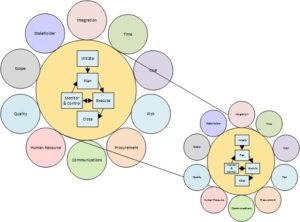 In my previous article “Progress Your Project with Processes” I discussed the need to incorporate processes in your project management solution delivery. In this article I would like to delve in to the need to right-size your processes for your project delivery.
In my previous article “Progress Your Project with Processes” I discussed the need to incorporate processes in your project management solution delivery. In this article I would like to delve in to the need to right-size your processes for your project delivery.
Most stakeholders feel that your project management processes are too heavy regardless of how much effort is expended in right-sizing them. I have heard this assertion on at least one occasion from an outside consultant, however when project execution was underway it was determined that the processes in place helped ensure that the delivery team understood the complexity of the effort and were empowered to deliver on their respective activities.
The main reason for this empowerment is because there was effective planning and communication at the beginning of the delivery and as a leader I was able to articulate the direction we as a team were embarking on. Stakeholder analysis up front and continued assessment are also key factors.
The complexity of your project needs to be considered along with the delivery methodology you intend to utilize. The more complex your project the more you need to rely on formal project management techniques.
I have found that there are three essential steps in determining how to right-size your project processes.
- Identify your delivery needs
- Select the tools to be used for delivery
- Adjust as you go
1. Identify your delivery needs
When identifying your delivery needs it is important to first decide on the software development life cycle (SDLC) methodology your project will be utilizing. The methodology in and of itself is not the key, but rather assessing the specific approach you will be taking and subsequently determining the impact of the methodology on your stakeholders are the keys. If your team is new to a specific methodology, then steps need to be taken up front to take them on the learning journey while continually communicating expectations throughout the delivery cycles. You may also find when reviewing your SDLC that adjustments need to be made to the methodology to better clarify the tools and techniques that will foster solid delivery. Some questions you need to think about should center around; is there an effective communication plan, is change management understood, how will the team be empowered to report activities, risks and issues, and how will lessons learned be gathered throughout to support reassessment.
2. Select the tools to be used for delivery
Selection of the tools may be driven by what is available within your company. I have found there are three main tool areas that need to be accounted for. These three areas relate to content management, development management, and test management. Content management would be the tool used for gathering and maintaining project specific documentation. As an example, you may find that it is easier to use a simple tool for managing actions, risks, issues, and decisions such as an Excel workbook, or in a more complex delivery you may want to track these items utilizing a formal content management tool and workflow. This is an area that should be right-sized based on the complexity of your project. If you are delivering using an Agile methodology you will want a development management tool that will support your product backlog grooming and the velocity tracking of your team such as Jira, Version One, or Rally. If you have a separate tool for managing test planning and execution it is important to guide your team through which tool will be used for communication management. For instance, defects may be captured in the test tool but communication with the development team may be captured in the development management tool.
3. Adjust as you go
Retrospectives and lessons learned activities are not only important for how your team works together, but also relevant for what processes need to be modified as you progress through your delivery efforts. If managing through a waterfall or iterative waterfall SDLC, at a minimum you will want to hold a formal lessons learned at each phase gate. If managing utilizing an Agile SDLC, you should ask your team to think about processes when completing their retrospective activities and support any suggestions they may have to update processes accordingly.
In summary, it is important to assess up front the appropriate project management processes that will be used to deliver the solution. In doing so you need to account for the complexity of the project and the communication mechanisms that are required. The tools you choose should support the activities to empower your project team to be self-organizing and you need to adjust as you progress through project delivery. Remember as always to have fun!



